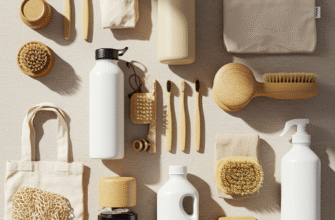In today’s fast-paced world, finding moments of calm can feel like a distant dream. Stress and anxiety seem to follow us everywhere, from demanding jobs to the constant stream of information bombarding our senses. But what if I told you that tranquility could be as close as a simple scent? Essential oils, nature’s fragrant gifts, have been used for centuries to promote well-being and emotional balance. Let’s dive into the aromatic world of essential oils and discover how they can help you cultivate a calmer, more centered life.
What are Essential Oils?
Essential oils are highly concentrated, aromatic extracts derived from plants. These oils capture the plant’s unique scent and therapeutic properties. They are typically extracted through distillation, often using steam, but can also be obtained through cold pressing, especially for citrus oils.
Think of it this way: imagine squeezing the peel of an orange. That burst of refreshing citrus scent is due to the essential oils residing in the peel. That’s just one example of the potent power these natural compounds hold. It’s a concentrated version of the plant’s essence.
How Essential Oils Work
Essential oils exert their calming effects through several pathways. Primarily, they interact with the limbic system, the part of the brain responsible for emotions, memories, and behavior. When you inhale essential oil molecules, they travel through your nasal passages and bind to olfactory receptors, which then send signals directly to the limbic system. This connection can trigger the release of neurotransmitters like serotonin and dopamine, which promote feelings of relaxation and well-being.
Furthermore, some essential oils have pharmacological properties that can directly affect the nervous system, helping to reduce stress hormones like cortisol. Topical application can also provide localized relief, as the oils are absorbed through the skin and enter the bloodstream.
It’s important to remember that essential oils are potent substances. Always dilute them properly before applying them to the skin, and avoid ingesting them unless under the guidance of a qualified aromatherapist.
Top Essential Oils for Calm
With so many essential oils available, it can be overwhelming to know where to start. Here’s a curated list of some of the most effective and popular essential oils for promoting calm and relaxation:
Lavender
Lavender is perhaps the most well-known and widely used essential oil for relaxation. Its floral, slightly sweet scent is incredibly soothing and has been shown to reduce anxiety, improve sleep quality, and promote a sense of peace. Studies have consistently demonstrated lavender’s efficacy in alleviating stress and promoting relaxation.
Chamomile
Similar to lavender, chamomile is revered for its calming properties. There are two main types of chamomile essential oil: Roman chamomile and German chamomile. Roman chamomile has a sweet, apple-like aroma and is often used to ease anxiety and promote restful sleep. German chamomile has a slightly more herbaceous scent and is known for its anti-inflammatory properties, making it beneficial for soothing irritated skin as well as calming the mind.
Frankincense
Frankincense has been used for centuries in religious and spiritual practices. Its warm, woody, and slightly spicy aroma is grounding and helps to promote a sense of inner peace. Frankincense is also believed to have anti-inflammatory and immune-boosting properties. It can be particularly helpful for those who struggle with racing thoughts or feelings of overwhelm.
Bergamot
Bergamot is a citrus fruit with a unique floral and citrusy aroma. Its essential oil is uplifting and mood-boosting, making it a great choice for combating feelings of sadness or depression. Bergamot can also help to reduce anxiety and improve focus. Be sure to use bergaptene-free (FCF) bergamot essential oil, as regular bergamot oil can cause photosensitivity.
Ylang Ylang
Ylang Ylang has a sweet, floral, and slightly exotic aroma. It is known for its calming and aphrodisiac properties. Ylang Ylang can help to reduce stress, lower blood pressure, and promote feelings of relaxation and well-being. Some find the scent very powerful, so it’s best to use it in moderation.
Sandalwood
Sandalwood has a warm, woody, and grounding aroma. It is often used in meditation practices to promote a sense of inner peace and tranquility. Sandalwood can also help to reduce anxiety and improve sleep quality. It is a precious and often expensive oil, so sourcing it from reputable suppliers who practice sustainable harvesting is important.
Clary Sage
Clary Sage has a herbaceous, slightly floral, and earthy aroma. It is known for its calming and hormone-balancing properties. Clary Sage can help to reduce stress, ease anxiety, and promote feelings of relaxation. It’s often used to alleviate symptoms of PMS and menopause.
How to Use Essential Oils for Calm
There are several ways to incorporate essential oils into your daily routine to promote calm and relaxation. Here are a few popular methods:
Aromatherapy Diffusers
Diffusing essential oils is one of the easiest and most effective ways to enjoy their benefits. Add a few drops of your chosen essential oil or blend to a diffuser filled with water, and let the aromatic molecules disperse into the air. You can diffuse essential oils throughout the day or before bedtime to create a relaxing atmosphere.
Different types of diffusers exist, including ultrasonic diffusers, nebulizing diffusers, and heat diffusers. Ultrasonic diffusers are the most common and use ultrasonic vibrations to create a fine mist of water and essential oil. Nebulizing diffusers disperse the essential oil directly into the air without water, resulting in a more concentrated aroma. Heat diffusers use heat to evaporate the essential oil, but this method can alter the oil’s chemical composition and is generally not recommended.
Topical Application
Essential oils can be applied topically to the skin, but it’s crucial to dilute them properly with a carrier oil such as jojoba oil, sweet almond oil, or coconut oil. A general guideline is to use a 1-3% dilution for adults, which translates to 1-3 drops of essential oil per teaspoon of carrier oil. For children, the elderly, and those with sensitive skin, a lower dilution is recommended. You can apply diluted essential oils to pulse points such as the wrists, temples, and neck, or massage them into sore muscles.
Always perform a patch test before applying essential oils to a large area of skin to check for any allergic reactions. Apply a small amount of diluted essential oil to a small area of skin and wait 24 hours to see if any irritation occurs.
Aromatic Baths
Adding essential oils to a warm bath is a luxurious and relaxing way to unwind. Add a few drops of your chosen essential oil or blend to a tablespoon of carrier oil or Epsom salts before adding it to the bathwater. This will help to disperse the essential oil evenly and prevent skin irritation. Soak in the bath for 20-30 minutes to allow the essential oils to fully absorb and exert their calming effects. Lavender, chamomile, and sandalwood are excellent choices for a relaxing bath.
Inhalation
Direct inhalation is a quick and easy way to experience the benefits of essential oils. You can simply inhale the aroma directly from the bottle or add a few drops of essential oil to a cotton ball or tissue and inhale deeply. Another option is to create a steam inhalation by adding a few drops of essential oil to a bowl of hot water and inhaling the steam with a towel draped over your head. This method can be particularly helpful for relieving congestion and promoting relaxation.
Massage
Massage is a wonderful way to combine the therapeutic benefits of essential oils with the physical benefits of massage. Choose a carrier oil and add a few drops of your chosen essential oil or blend to create a massage oil. Use gentle, flowing strokes to massage the oil into your skin. Focus on areas that are prone to tension, such as the neck, shoulders, and back. Professional massage therapists are often trained in aromatherapy and can create custom blends tailored to your specific needs.
Creating Calming Essential Oil Blends
Experimenting with different essential oil blends can be a fun and rewarding way to discover new aromas and create custom blends that suit your individual needs. Here are a few calming blend ideas to get you started:
Sleepy Time Blend
- 3 drops Lavender
- 2 drops Chamomile
- 1 drop Sandalwood
Stress Relief Blend
- 2 drops Bergamot
- 2 drops Frankincense
- 2 drops Ylang Ylang
Anxiety Ease Blend
- 3 drops Lavender
- 2 drops Clary Sage
- 1 drop Frankincense
Uplifting Calm Blend
- 2 drops Bergamot
- 2 drops Lavender
- 1 drop Geranium
Remember to adjust the ratios of essential oils to suit your personal preferences. Start with a small amount of each oil and gradually add more until you achieve the desired aroma.
Safety Considerations
While essential oils are generally safe when used properly, it’s important to be aware of potential safety concerns.
- Dilution: Always dilute essential oils before applying them to the skin.
- Pregnancy and Breastfeeding: Some essential oils are not safe to use during pregnancy or breastfeeding. Consult with a qualified aromatherapist or healthcare professional before using essential oils if you are pregnant or breastfeeding.
- Children: Use essential oils with caution around children. Some essential oils are not safe for young children. Always dilute essential oils properly and keep them out of reach of children.
- Pets: Essential oils can be toxic to pets. Avoid diffusing essential oils around pets and never apply essential oils directly to their skin or fur.
- Allergies: Be aware of potential allergies to essential oils. Perform a patch test before using a new essential oil.
- Photosensitivity: Some essential oils, such as bergamot, can cause photosensitivity. Avoid exposure to sunlight or tanning beds after applying these oils to the skin.
- Quality: Choose high-quality, pure essential oils from reputable suppliers. Look for oils that are GC/MS tested to ensure their purity and quality.
Always store essential oils in dark, airtight containers in a cool, dry place. Exposure to light and heat can degrade the quality of the oils.
Beyond the Scent: Creating a Calming Lifestyle
While essential oils can be a powerful tool for promoting calm, it’s important to remember that they are just one piece of the puzzle. Cultivating a truly calm and balanced life requires a holistic approach that incorporates other healthy habits, such as:
- Mindfulness and Meditation: Practicing mindfulness and meditation can help you to become more aware of your thoughts and feelings, allowing you to respond to stress in a more calm and centered way.
- Regular Exercise: Exercise is a great way to reduce stress and improve mood. Aim for at least 30 minutes of moderate-intensity exercise most days of the week.
- Healthy Diet: Eating a healthy diet rich in fruits, vegetables, and whole grains can help to nourish your body and mind, reducing stress and improving overall well-being.
- Sufficient Sleep: Getting enough sleep is crucial for managing stress and maintaining good health. Aim for 7-8 hours of sleep per night.
- Connection and Social Support: Spending time with loved ones and connecting with others can help to reduce stress and promote feelings of belonging and support.
- Spending Time in Nature: Spending time in nature has been shown to reduce stress, improve mood, and boost creativity.
By combining the power of essential oils with these healthy lifestyle habits, you can create a truly calm and balanced life.
Conclusion
Essential oils offer a natural and effective way to promote calm and relaxation. From the soothing scent of lavender to the grounding aroma of frankincense, these aromatic extracts can help you to ease stress, reduce anxiety, and cultivate a sense of inner peace. Experiment with different essential oils and blends to discover what works best for you. Remember to use essential oils safely and responsibly, and to incorporate them into a holistic lifestyle that prioritizes well-being.
So go ahead, embrace the aromatic world of essential oils and unlock the power of scent to create a calmer, more centered, and more joyful you. Your journey to tranquility awaits!








